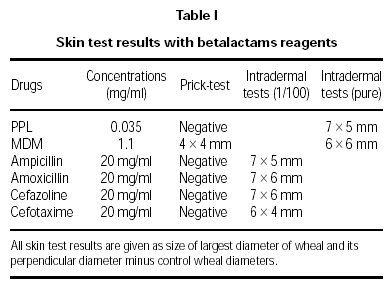INTRODUCTION
The management of the patient who has a history of penicillin allergy include skin testing to determine if penicillin-specific IgE antibodies exist, and desensitization if penicillin is the choice treatment1. Especially when no proven alternatives to penicillin are available for treating neurosyphilis, congenital syphilis, or syphilis in pregnant women and it is not possible choosing an alternative non betalactam antibiotic2.
We report a case of successful desensitization to penicillin in a pregnant woman with latent syphilis and penicillin allergy, where the first penicillin study was not positive, but the repetition of diagnosis test (reassessment) with the same betalactam reagents than in the first study two weeks later was positive, detecting allergic sensitization not detected previously.
CASE REPORT
We studied for a second time, a 30 year-old pregnant woman with latent syphilis (RPR positive, IgM ELISA positive and FTA Abs positive) and penicillin allergy. One year before was evaluated in our outpatient clinic because a history of immediate angioedema to penicillin when she was only two years old, resulting in a positive intradermal skin test to the minor determinant mixture reagent (wheal of 7 x 5 mm with a flare). She had a past history of previous aborts, nephritic colics and adverse reactions to Sulfonamides and Streptomycin.
This time, the patient underwent skin tests with standard concentrations of Penicilloylpolylysine (Allergopen®, Reinbek, Germany), Minor Determinant Mixture (Allergopen®) and Ampicillin, Amoxicilin, Cefazoline, Cefotaxime diluted in 0.9 % sodium chloride and used at concentrations of 20 mg/ml in prick method and 0.2 mg/ml and 2 mg/ml in intradermal method, with positive and negative controls. Specific IgE to penicilloyl G, penicilloyl V, ampicilloyl and amoxicilloyl (UniCAP specific IgE; Pharmacia, Uppsala, Sweden) were negative too (< 0.35 kU/l). Upon negative skin tests and specific IgE results, we performed single-blind, placebo-controlled oral challenge test in the hospital with oral potassium fenoximetilpenicillin. Increasing amounts (5 mg, 50 mg, 500 mg) of the therapeutic doses (555 mg = 880.000 IU), indicated in parentheses, were administered at 1-h intervals, with excellent tolerance. But owing to private problems the patient could not be admitted to the hospital and came back two weeks later.
As we were not confidence with the result of the tolerance test we performed a second skin tests with the same reagents (reassessment) with positive results to Penicilloylpolylysine, Minor Determinant Mixture, Ampicillin, Amoxicillin, Cefazolin and Cefotaxime (table I), but negative specific IgE to reagents above mentioned.
So therefore and after obtaining written, informed consent the patient was proposed to desensitization. Doses of 500, 5000 and 40000 IU of fenoximetilpenicillin was prepared. The specific amount of drug was diluted in 30 mL of water and administered orally with 15 minutes interval between doses, and elapsed time 4 hours and cumulative dose, 1.288.000 units. The patient was treated with 2.400.000 UI of Penicillin G i.v. every 4 hours during 10 days. The patient was admitted in ICU and monitorizaded during all the procedure, including the first two i.v. doses of penicillin. No reactions were observed during the desensitization protocol and treatment.
A follow up study was done one year later with new skin tests with the same reagents and positive results to Penicilloylpolylysine, Minor Determinant Mixture, and Ampicillin, but negative to Amoxicillin, Cefazolin and Cefotaxime. Specific IgE was again negative. By the second year all the tests were negative, including skin and serologic tests, challenge test and a new reassessment.
After oral controlled administration of penicillin in patients with skin tests and RAST negative, repetition of diagnostic tests (reassessment) with betalactam reagents two to four weeks after initial evaluation can be of value to detect allergic sensitization not detected at the previous examination3-5.
DISCUSSION
Detection of IgE antibodies in the skin or serum depend on the time interval between the reaction and the study, because skin test sensitivity decrease with time6. This loss of sensitivity varies individually, but no sufficient studies have been carried out to examine it. The reason for the variability in the skin test response may be genetic or environmental because uncontrolled or hidden contact with betalactams antibiotics can occur, which could maintain sensitization7.
Allergic diseases are unpredictable more, less severe, or unchanged in pregnant women8. Little specific information is available concerning the relative susceptibility of pregnant women to anaphylaxis or acute desensitisation9. This case demonstrates that in a patient allergic to penicillin, in whom there is a vital indication to administer this compound, the drug can be given safely after tolerance induction or desensitization.






